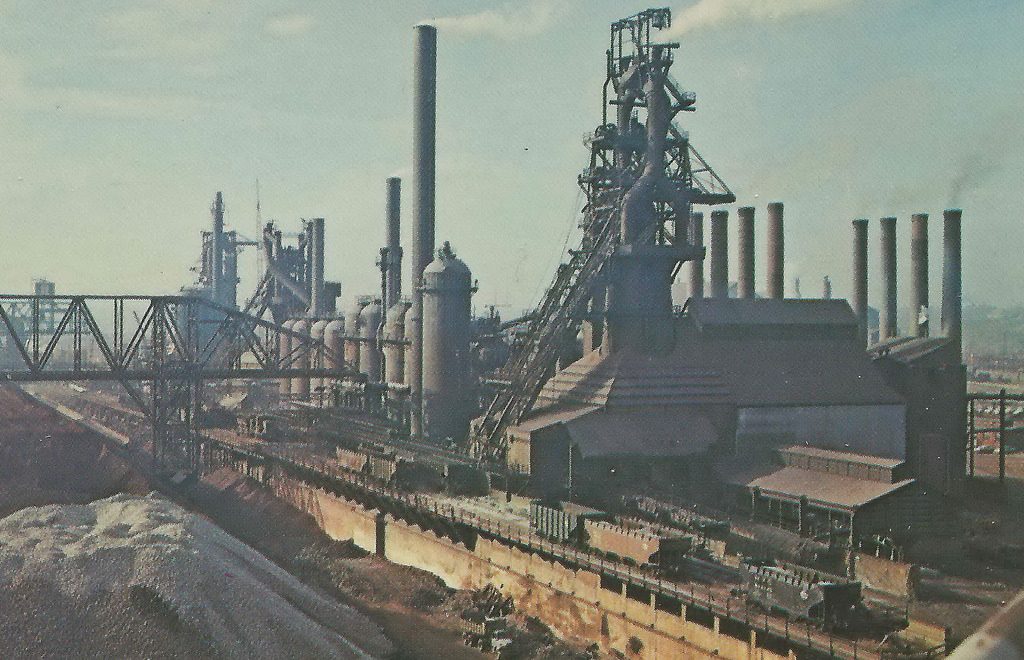Part of the shift towards a focus on economic vibrancy is helping communities explore growth in the context of their own economic reality, in order to catalyze an era of growth that is smart, shared, and sustainable. When thinking about economic development, it is important to think “what can we realistically do with the resources we have in our community, right now?” This blog will help provide context for where we’ve been; where we are now; and where we might be going.
Ohio’s Economic History – where have we been?
Most early Ohio settlers were involved in agriculture. As Ohio’s population grew in the nineteenth century, many residents began to diversify their economic interests; with some Ohioans venturing into industrialization.
Coal mining began in Ohio during the 1810s and 1820s. Most of Ohio’s coal mines existed in eastern and southern parts of the state. Coal drove industrialization following the Civil War. In 1872, Ohio mines produced more than five million tons of coal. However, by the late nineteenth and early twentieth centuries, the demand for coal began to decline. Oil and natural gas became more popular fuel sources, creating less pollution and increasing the efficiency of machinery.
By the mid to late nineteenth century, a number of Ohio cities had emerged as industrial centers, including Dayton, Springfield, Columbus, Akron, Toledo, Cleveland, and Cincinnati. As a result, the populations of these cities had grown tremendously. Ohio became one of the wealthiest states in the country.
As these industries gained a more important role in the state’s economy, they also made Ohioans more susceptible to downturns in the national economy, such as panics and depressions. The Panic of 1819 provided an early warning of this consequence, but later economic problems in the 1870s and 1890s, as well as additional problems in the twentieth century, reinforced the lesson.
Ohio’s Economic Profile – where are we now?
Ohio’s per capita income and population has been growing slower than the national average. Despite this, Ohio remains the 7th most populated state for now. Ohio’s population is spread throughout the state with several major cities. Columbus currently has the highest population with 850,000 residents, followed by Cleveland (388,072), Cincinnati (298,550), Toledo (298,550) and Akron (197,542).
Interestingly, these cities vary greatly when it comes to their demographics and growth. While Columbus has been growing at a rate of 10% each decade, Cleveland saw their population peak several decades ago. In 1950 Cleveland had almost one million people, but has been experiencing a steady decline since then. In 2000, approximately 500,000 people resided in the city; today, that number is in the 300,000. Population declines can be a serious issue as losing residents makes it harder for cities to collect the taxes needed to pay for fixed costs and can stifle efficiency and vibrancy of a dense urban core.

In per capita income, Ohio ranked nineteenth in the nation, with residents earning $28,400 each. In April 2018, Ohio’s unemployment rate was recorded at 4.3 percent, compared to 5.1 percent a year ago. The national rate for April 2018 was 3.9 percent. Ohio employment peaked in 2000 with a little over 5.6 million jobs. Ohio has been especially hurt by declines in manufacturing employment, especially in motor vehicle and motor vehicle parts manufacturing.
Hoping to secure higher paying jobs in technology or service industries, many workers have sought retraining at Ohio’s institutions of higher education, which have been experiencing rapid growth. The following is a list of Ohio’s top five employers with headquarters in the state.
| Top State Employers | Number of Ohio Employees | Headquarters location |
| Cleveland Clinic Health System | 49,800 | Cleveland |
| Kroger | 45,150 | Cincinnati |
| The Ohio State University | 33,300 | Columbus |
| Mercy Health | 32,200 | Cincinnati |
| Wright Patterson Air Force Base | 27,600 | Dayton |
As you can see, 3 of the top 5 employers are in the fields of Health and Education. In 2008, Ohio was ranked first in the Midwest and fourth in the nation for biotech industry strength by Business Facilities magazine. As of 2008, there were over 1,100 biotech related firms operating in the state.
Ohio 2022 Employment Projections – where are we going?
The Department of Job and Family Services released 2022 employment projections for the state of Ohio. These projections are based on the most current data available at the time they are made; they are estimates of future employment if there are no changes in the current situation.
The document reports that the number of jobs for Ohioans is expected to rise from 5.502 million in 2012 to 5.957 million by 2022, an increase of more than 455,000 jobs. As seen below, service-providing industries are expected to add 426,190 jobs, an increase of 10.0 percent. While goods-producing industries are expected to add 19,540 jobs, an increase of 2.1 percent.
The graph below shows the employment change expected for each industry sector between 2012 and 2022. Service-providing industries are denoted by a dark red, and goods-producing industries are the gray. Among the goods-producing sectors, construction and mining, quarrying, and oil and gas extraction are projected to grow by 41,000 jobs and 500 jobs, respectively. Manufacturing, on the other hand, is projected to shrink. Growth among the service-providing sectors will be led by the health care and social assistance industry, which is expected to add more than 166,000 jobs, a 22.2 percent increase.

Discussion
Do the realities of a post-recession economy demand that we (residents, local, state and federal government, civic, business and philanthropic leaders) adjust our strategies?
What do you see as the most pressing economic issue in your community?
Let us know your thoughts! To follow our new research and research of our local media partners, sign up for our weekly news roundup.






My biggest question: So despite President Trumps attempts to bring manufacturing back to the United States and working on better trade deals, there will still be a loss in manufacturing jobs and Agriculture, Forestry, Fishing and Hunting? (looking at the last graph shown in the article) Could that prediction be due to the bias of our Governor toward our President or is there data that backs that up. I looked on the 2022 employment projections web page, but it didn’t seem to address it.
This is a good article, however, a more in depth summary would have been nice. As I read and looked closely at the graphs presented, I kept asking myself what are the reasons behind the data? I came up with a few reasons on some of them, but not all. For example, why the increase in folks 55+ in the work force since 2002? Is it because they have massive debt, still paying for their children, they have not planned for retirement or because the number of younger people in the work force has decreased? (This from Ohio’s 2022 employee projections web page)
Hey June,
These projections were actually released before President Trump came into office, so I don’t think it contains any bias against him. The projections are based on the most current data available at the time they are made (so 2012 for this one); they are estimates of future employment if there are no changes in the current situation. So technically, things could turn out a little differently since Trump came into office but based on the trends of Ohio’s economy and the U.S. economy, it will most likely be something similar to the projections. Also, since the projections were released, Ohio’s economy has continue to move in the direction predicted. Which isn’t necessarily a bad thing since overall employment is expected to rise in the next few years for Ohio.
June: Thanks for your question. I’ll add some information regarding your final question about the reasons people over 55 will continue to work. For most people, this is not a matter of bad choices. Instead, the number one reason is the federal government requires people to work longer. A few years ago, one need only work to age 65 to achieve full benefits under Social Security. Today, a person must be at least 66 and two months or face a significant reduction in benefits. People born in 1960 or later must be 67. Because this age group is the gigantic Boomer generation, requiring them to work longer has a profound impact on the work force — and reduces the job opportunities for their children who are looking for work. Add to this the fact that many late Boomers became employed with the understanding that they would have pensions — only to have them cancelled and in some cases go bankrupt after 2008. They have not had time to create a backup. Add to this one last item: In the good old days, Ohio’s manufacturing industry offered supplemental health care benefits for retirees. No more. Health care — including Medicare — is expensive. If you have a job with benefits, there is one more reason to stay employed until full Social Security benefits or longer.